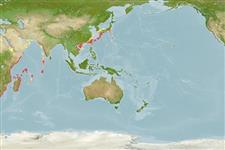>
Pleuronectiformes (Flatfishes) >
Soleidae (Soles)
Etymology: Aseraggodes: Greek, aggos, -eos, -ous = vessel, uterus, carapace of a crab + Greek, aseros, -a, -on = to remove the appetite (Ref. 45335).
Environment: milieu / climate zone / depth range / distribution range
Ekologi
laut dasar (demersal); kisaran kedalaman 6 - 10 m (Ref. 56490). Temperate
Indo-West Pacific: Sodwana Bay (South Africa), Porto Amelia (Mozambique) and Japan.
Size / Weight / umur
Maturity: Lm ? range ? - ? cm
Max length : 8.0 cm TL jantan/; (Ref. 3200)
Duri punggung (Keseluruhan (total)): 0; duri punggung lunak (Keseluruhan (total)): 64-67; Duri dubur 0; Sirip dubur lunak: 42 - 44; vertebrata, bertulang belakang: 33 - 34. Diagnosis: Dorsal rays 64-67; anal rays 42-44; dorsal and anal rays are not branched. Caudal rays 18, the middle 14 branched. Lateral-line scales of ocular side 64-67; the line extending forward nearly to upper eye, with a ventral branch on head following the edge of the preopercle. Vertebrae 10 + 23-24. Dorsal pterygiophores anterior to fourth neural spine 14-15. Body depth 2.4-2.5 in SL; head length 3.55-3.65 in SL; snout long, 2.6-2.95 in head length; interorbital space narrow, 13.7-20.8 in head length. Caudal peduncle very short, 19.5-23.2 in HL. Tubular anterior nostril anterior to upper edge of lower eye, just reaching cutaneous edge of lower orbit when depressed posteriorly. Two rows of scales in interorbital space, none extending onto medial edges of eyes. Anterior edge of snout of largest specimen (23 mm SL) with a series of 12 conspicuous lappet-like cirri. Ventral margin of head with 20 similar cirri, the longest on chin about equal to pupil diameter; no cirri on opercular edge of either side of gill opening. Jaws of blind side surrounded by a zone of small papillae. Dorsal and anal rays long, the longest dorsal ray 2.5-3.0 in HL. No sheath of scales over base of dorsal and anal fins, at most one row of scales over basal part of rays. Rounded caudal fin and moderately long, 3.2-3.45 in SL. Pelvic fins long, reaching base of third or fourth anal ray, 1.65-1.9 in HL. Color of ocular side when fresh light gray with large irregular dark-edged white spots on head and body, scattered small whitish spots, fewer small black spots, a black spot the size of eye on lateral line in middle of body and a double black spot on lateral line in middle of posterior half of body (Ref. 56490).
Inhabits sand bottoms including reef flats and tide pools in 0-10 m (Ref. 90102).
Life cycle and mating behavior
Kematangan | Reproduksi, perkembang biakan | Pemijahan | telur-telur | Fecundity | Larva
Heemstra, P.C. and O. Gon, 1986. Soleidae. p. 868-874. In M.M. Smith and P.C. Heemstra (eds.) Smiths' sea fishes. Springer-Verlag, Berlin. (Ref. 3200)
Status IUCN Red List (Ref. 130435)
ancaman kepada manusia
Harmless
penggunaan manusia
informasi lanjut
Nama-nama umumSinonim (persamaan)metabolismePemangsaEkotoksikologiReproduksi, perkembang biakanKematanganPemijahanSpawning aggregationFecunditytelur-telurpekembangan telor
AcuanBudidaya airprofil budidaya airStrainGenetikaElectrophoresesDiturunkanPenyakit-penyakitPengolahanNutrientsMass conversion
mitraGambarStamps, Coins Misc.Suara-suaraCiguateraKecepatanTipe renangArea insangOtolithsOtakPenglihatan / visi
Alat, peralatan
laporan khas
muat turun XML
Sumber internet
Estimates based on models
Preferred temperature (Ref.
123201): 23.5 - 28.9, mean 27 °C (based on 509 cells).
Phylogenetic diversity index (Ref.
82804): PD
50 = 0.5000 [Uniqueness, from 0.5 = low to 2.0 = high].
Bayesian length-weight: a=0.00977 (0.00473 - 0.02021), b=3.07 (2.90 - 3.24), in cm total length, based on LWR estimates for this (Sub)family-body shape (Ref.
93245).
Trophic level (Ref.
69278): 3.4 ±0.5 se; based on size and trophs of closest relatives
Daya lenting (Ref.
120179): Tinggi, Waktu penggandaan populasi minimum kurang dari 15 bulan (Preliminary K or Fecundity.).
Fishing Vulnerability (Ref.
59153): Low vulnerability (10 of 100).
